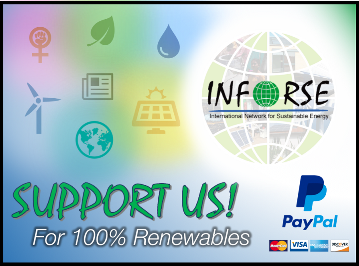|
|
|
|
|
|
|
|
|
|
|
|
|
|
|
|
|
|
|
|
|
| Follow Us: |
| Backcasting Sustainable Energy in Argentina | |
| INFORSE workshop proposes wind, PV, and energy efficiency to replace nuclear and large hydro in Argentina’s future energy system. | |
| Backcasting | |
| One method of strategically planning for sustainability is often referred as “backcasting.” It is a systematic, step-by-step approach that defines a framework for sustainability as a guideline for today’s measures. A core activity of the INFORSE workshop in Argentina in December, 1997 was a backcasting exercise for wind energy, photovoltaic energy, and energy efficiency to help mitigate climate change. | |
| Wind Energy | |
| For wind energy, we assume market penetration of 10% of demand by 2010, equal to 4.5 GW installed capacity. It is also assumed (Shell International Limited, 1996) that a reduction of between 50% and 33% in the cost of wind energy will be achieved by the year 2010. For the year 2020, one forecast indicates an increase in energy demand by 50% from the year 2010. Under this circumstance, the following scenarios were considered: Wind-energy penetration of 10%. Up to 40% wind-energy penetration. In this scenario, the Argentinean grid system will be strongly interconnected with those of Brazil and other countries. There will be specific market niches for the energy surplus from intermittent resources such as storage systems, industrial uses (for instance, hydrogen), etc. | |
| Photovoltaic Energy | |
| For photovoltaic energy, we assume market penetration of 3.5% of demand with an installed capacity of 2.4 GWp. This value was chosen after taking into account the present rural electrification program and its implications in the next several years, as well as the creation of decentralised photovoltaic systems interconnected to the grid. It is also assumed that a reduction in the cost of the photovoltaic module to $2 US/Wp -$1 US/Wp will be achieved by the year 2010. The 2020 scenario considered up to a 10% of photovoltaic-energy penetration. In this scenario, the Argentinean grid system will be strongly interconnected with those of Brazil and other countries. Provision will also be made for market niches for the energy surplus from intermittent resources. | |
| Rational Use of Energy | |
| The energy-efficient scenario discussed was calculated under the hypothesis that all of the available and economically feasible technologies are taken into account. Under this hypothesis, reductions of electricity consumption by 30% and 40% by 2010 and 2020, respectively, can be achieved. | |
| Comparison with Governmental Study | |
| The Argentine government has implemented the “Study Project on Climate Change” in Argentina for the Climate Convention. This includes a project on mitigation of greenhouse gas (GHG) emissions. The scenario developed in this mitigation project concludes that a 6% reduction in electricity demand by 2010, and a 9% reduction by 2020, will be achieved under energy-efficiency programs. In the mitigation scenario, hydroelectricity and nuclear energy are the chosen substitutes for fossil fuels, while the penetration of renewable energies (except hydro) is almost negligible. The study is too conservative with respect to the competitiveness of PV and wind energy when compared with the assumptions in our study. Our technological learning curves were taken from three different studies: TERES II, DEO, and IIASA*. Further, our projections assume that regulatory changes will be adopted to optimise integration of intermittent sources. In this way, higher market penetration can be achieved by renewable-energy technologies, and neither new nuclear power plants nor new mega-hydroelectric plants are needed. | |
| Official Planning Challenged | |
| At two seminars in June, 1998 attended by representatives of electricity cooperatives, NGOs, and energy officials, INFORSE Argentina challenged official views of the energy future with the results of its backcasting. Harsh discussions took place about the regulatory framework, the economic incentives, and the prospects of the technologies. The reliance of the government on fossil fuel became apparent just at a time when renewables legislation is being discussed in the Parliament. The legislation calls for a $0.01 US per kWh for wind electricity. The seminars also provided a forum for interesting exchanges of views with regard to the jobs issue and the policies needed to enforce the legislation currently considered by the Parliament, including the need for research, development, and dissemination. Danish experience in this was brought into the discussion by two Danish participants from the Danish Energy Agency. * Reference to the studies: -TERES II, Alterner Program European Commission. ESD Ltd. The European Renewable Energy Study, 1995-2020. - Commercialisation of Utility PV Distributed Power Systems, D.E. Osborn SMUD, Proceedings ASES, 1997. - IIASA, International Institute for Applied Systems Analysis, Global Energy Perspectives to 2050 and Beyond, 1995. Information and copy of article: INFORSE Latin America coordinator , c/o REJIMA, Mario Bravo 1029 piso 4 depto.A, 1175 Buenos Aires, Argentina Ph/fax: +541-963-0722, e-mail: rq@rejima.uba.ar , or marceloalvarez@ciudad.com.ar | |

| |
| Published in Sustainable Energy News |
|
|
Go back to main page of ISSUE #22, Sustainable Energy News (16 pages) (1998-09-01) |
|
| Contact | |
| |
INFORSE Secretariat Klosterport 4F, 1. floor DK-8000 Aarhus C Denmark Phone: +45 86 22 70 00 Twitter: INFORSE_org Facebook: INFORSE Web: inforse.org E-mail: ove@inforse.org |
